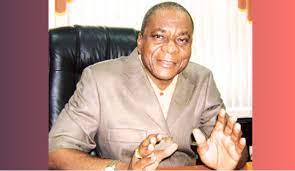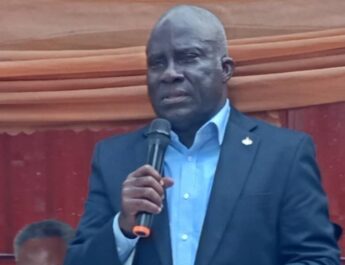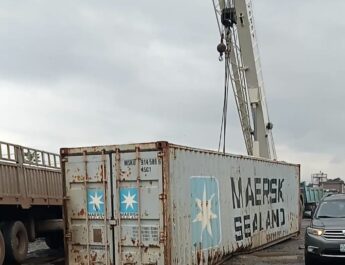Ola Oresanya is the Commissioner for Environment in Ogun State, in this interview, he reveals efforts by Ogun State Government to resist flooding of the state this year to Raymond Tedunjaye
What efforts is the state making to prevent the predicted flooding by meteorologists during the rains?
For us in Ogun State, we have three partners of flood, we’ve the flash flood, the river flood and coastal flooding and these are predictable extreme weather conditions scientifically, if you look at history of weather partner in this part of the world. So for the first set of flood which is the flash flood, which does occur between the month of April and July, we had prepared for it by giving our people information about the partner of the flood, the full velocity and runoffs of water. We made people to realise that, and we worked seriously in that direction to make sure that the impact was at the barest minimum. The devastation you witnessed in many other states, we don’t have it in Ogun State during the first set of rain fall. Now, the second set of flooding, which is the river flood will be coming in the month of September and we have a lot to do with Ogun River. Ogun River takes its source from Shaki, that river flows into Ogun State from other tributaries and these are trans-boundary flow, some are coming as far as the northern part of the country and outside Nigeria, and Ogun State is where this water will empty into the lagoon through Lagos. These are critical issues that Ogun State must prepare for, and we have the knowledge about the pattern of the rain, we have knowledge about the behavioral pattern of the river and we have knowledge about the tidal flows. In preparing for the river flooding which we are expecting from the month of September, the people living at the river banks are going to be impacted. We have been giving information and we are still going to be giving them information about the expected time of the arrival of the flood. The expected time of the flood that is coming from the Northern part of Africa, that has entered Nigeria and most of the cities in the North are already having the impact, will get to Ogun State between September 8 and September 10, that is the arrival time of the excess water. The first dam that will detain the excess of the water is Oyan Dam, because they release water all year round. That dam has the capacity to detain so much water in the month of September and by the time it gets to the level of releasing water, they release about two million cubic metres on daily basis.
Now, the dispatcher extent of water along the Ogun Rivers itself would flow like about five to 10 metres in excess from the two sides of the river. So, anybody within the two sides of the river between the month of September and middle of October is going to have the impact of the excess water. From the middle of October to the end of October in Ogun State, we are going to have a tidal loss from the Atlantic Ocean, the water released from Oyan Dam will slightly increase.
So, to mitigate the impact of flooding, we have dredged the Alagbole River, we have dredged the Opaaro stream, because these are tributaries to the Ogun River, they’ve not been dredged for years. We finished it around April this year, and we are expecting that these are channels that will give a relief to the people around Isheri and Berger area.
However, there is still going to be some flood, but the impact will not be as much as what we used to have. Generally this year, we don’t expect the effect to be devastating as what we used to have in the past.
Erosion is another worrisome issue in some parts of the state, what information is available to the people living in and around prone areas, and what mitigation plan does the state have?
Well, if you look at it, there’s a different between flooding and erosion. Erosion is associated more with flash flooding on high speed. But when it comes to river flooding and coastal flooding, except may be coastal erosion which comes with high impact of wave. It has to do with high velocity in the hydro methodological structures and indexes. It’s that variation that causes erosion. Runoffs at a higher elevation to lower elevation at a higher speed, or the dissipation of underground water to break the void, cause erosion or irresponsible mining. So, in Ogun State, where we have dominant gully erosion is in the southern part, where we have the sedimentary beds. These are areas where we have soft ridges, made of clays, not like the ones we have in the northern part. These erosion sites are natural erosion sites, and these are ecological disasters. We have compiled them and we’re working with the Office of the Secretary to the Federal Government, which is the office of the Ecological Fund office to have support in addressing this ecological disaster. Again, areas where we see that human activities are opening up the gully erosion, we’re doing what is known as slope stabilisation, especially at mining sites, to stop the trend and re-stabilise the slope either by vegetal or stone pitching. These are agricultural and engineering solutions.
As Ogun State is fast rising up to Lagos in terms of infrastructural development, how prepared are you to face the challenges of environmental pollution and degradation?
Yeah, when you look at environmental degradation, it comes with development and that is the price to pay for development. Wherever there is development, there’s degradation and that’s why the principle of sustainable development plan comes in. If you’re tenacious enough to implement all the focus on the seventeen goals in SDGs, which include smart city, sustainable water and industrial development, you will be able to live in mega cities sustainably. Lagos is a mega city and it comes with a mega problem and the demand for infrastructure can be over stretching, which is the Lagos experience.
Now, look at Lagos and Ogun, they’re almost like no difference. In some houses around the border towns, your sitting room may be in Lagos, while your bedroom is in Ogun. That tells you that there is a shared headache between the two states. We have to do a lot of catch up to make sure that while Lagos is deploying its resources for human development, Ogun must not be lacking behind so that it will compliment what Lagos is doing. If Lagos is developing and Ogun is not, Lagos is going to be in trouble and if we are not development in the same pace, it will be discouraging.
For environmental pollution, Ogun is the most industrialized state in Nigeria now, we have industries growing up on daily basis in Ogun. When it comes to population growth, we have one of the highest, our annual growth is almost 50 per cent. Understandably too, Lagos is breeding into Ogun State on daily basis and there is land for development and it comes with the headache of Lagos. The first indicator is waste management. Before this administration there was no institution for waste management, it is the administration of Prince Dapo Abiodun, CON, that established the first institution for managing waste in Ogun State, that is Ogun State Waste Management Authority and it is addressing waste problems seriously. The other one is pollution from the industries. We are developing what we call our major drainage plan for the state, we are developing an integrated drainage plan, taking advantage of transverse river, that will be our major collector. We have our primary, secondary and tertiary collectors for each of the cities that will empty itself into the major collector, that’s the Ogun River and the tributaries. The contract has been awarded and the job is ongoing. All our treated effluent would be discharged through the trucks into the major collector. For the industrial emission, we’re very conscious of that. If you go through Ogijo area, this is where we have the highest volume of ferous and non-ferous recycling in Nigeria. On that axis alone, we have more than 1,500 metric tons of ferous and non-ferous metal being recycled on daily basis, and it comes with gaseous emission which is affecting the lives of the people. What we’re doing is, apart from the various sanctions, we’re now helping them to develop their various capacities and buying the pollution prevention devices. So, there are major development we have to do in Ogun to make it more habitable, sustainably and more forward looking, to make sure that the mistake Lagos made, Ogun must not make it.




